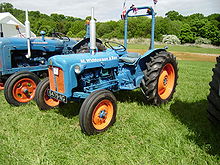A rollover protection structure or rollover protection system (ROPS) (/roʊps/ or /ˌɑːroʊpiˈɛs/) is a system or structure intended to protect equipment operators and motorists from injuries caused by vehicle overturns or rollovers. Like rollcages and rollbars in cars and trucks, cabs, frames or rollbars on agricultural and construction equipments, a ROPS involves mechanical components attached to the frame of the vehicle that maintain a clearance zone large enough to protect the operator's body in the event of rollover.



Commonly found on heavy equipment (i.e. tractors), earth-moving machinery and UTVs used in construction, agriculture and mining, ROPS structures are defined by various regulatory agencies, including US Occupational Safety and Health Administration (OSHA)[1] and international standard organizations such as ISO and OECD.[2] The regulations include both a strength requirement as well as an energy absorption requirement of the structure. Some dump trucks add a protrusion to their boxes that cover the operator's compartment for ROPS purposes.
ROPS are commonly fitted to 4x4s, pickup trucks, earth moving equipment, soil compactors and utility vehicles used in the mining industry. Products such as this were developed out of necessity so employees travelling around or within mine sites were provided with extra protection in the event of a fleet vehicle rollover.[3]
In the US, ROPS designs have to be certified by a professional engineer, who will normally require a destructive test. The structure will be tested at a reduced temperature (where the metal is more brittle), or fabricated from materials that have satisfactory low temperature performance.[4] The International Organization for Standardization has guidelines for destructively testing ROPS structures on earthmoving machinery, excavators, forestry equipment and tractors. Theoretical performance analysis of major new design ROPS is not permitted as an alternative to physical testing.[5]
- ^ See OSHA Roll-Over Protective Structures, Direct Final Rule.
- ^ "OECD Tractor standard Codes".
- ^ "History of ROPS". Minecorp. Archived from the original on 11 April 2013.
- ^ "Agricultural Safety and Health". web.extension.illinois.edu/agsafety/factsheets/rops.cfm. 2017. Retrieved 29 March 2017.
- ^ "ISO Update". International Organization for Statistics. May 2015.